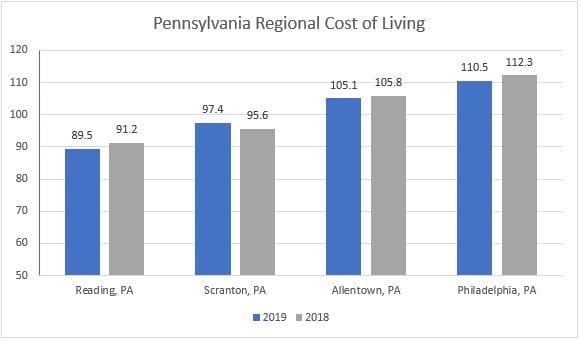For the second time in two years, the Reading Chamber Alliance (GRCA) participated in the Cost of Living Index through Council for Community and Economic Research (C2ER). C2ER weighs the cost of living information relative to government survey data on expenditure patterns for the top fifth of earners. There are 6 main areas that make up the categories for the index: Grocery items (13.40%), housing (29.34%), utilities (8.94%), transportation (9.22%), health care (4.26%) and miscellaneous goods and services (34.48%). Each of these categories and their weights contribute to the composite index, or the areas cost of living number.
There are a total of 60 items used to score an area’s cost of living. Some of these items are standard like gasoline, rent, a gallon of milk, however, some items are a bit more abstract. Items like a 3 pack of Penn Brand Tennis Balls, a pair of boy’s jeans and yoga classes also tie into the pricing of an area. These items are not something one would typically expect to be used to price the cost of living. Next time you see a tennis ball, maybe it will remind you of how there are so many factors which play a role in a region’s cost of living.

This year, the cost of living in the Reading MSA (as defined as Berks County) is 89.5 on a 100-point scale. Anything below 100 is considered more affordable than average, anything above 100 is considered more expensive than average. Berks County falls 11.5 points below average for our cost of living compared to the nation. So, what is driving this score? Our housing plays a large part. As mentioned above, housing accounts for nearly 30% of the total score. Our housing score for Q3 2019 was 78.1 The homes and apartments priced are standardized across the country with specific requirements. This low score shows how the affordability of housing in our community helps make our region an attractive place to live.
Berks County’s score is lower this year than last, not because the prices of goods and services have not increased, but because these prices have increased more slowly than the national average.
In comparison to other local regions, Berks County scores much better in terms of affordability. For example, Allentown received a score 105.1, making it a more-expensive-than-average place to live. On the other hand, Berk County’s positive cost of living score helps highlight this region’s affordability to live, work and do business.

